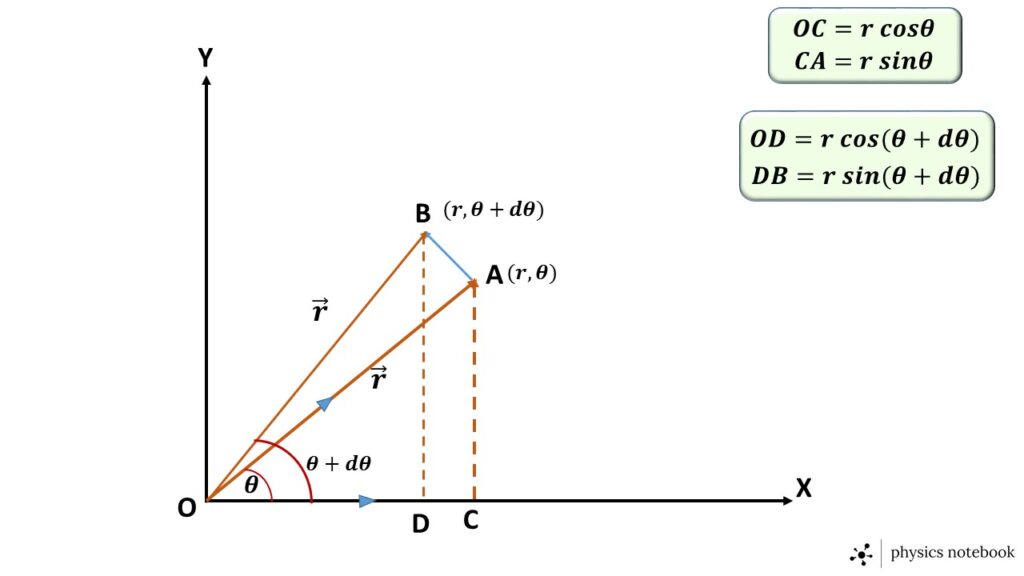In a two-dimensional plane polar co-ordinate system, there are two unit vectors\( \cdots \)
- The radial unit vector \( \hat{r} \). The direction of this unit vector is along the radius vector \( \vec{r} \)
- The unit vector \( \hat{\theta} \) along the direction of increasing \( \theta \).
Similarly, in case of planer motion in a two-dimensional Cartesian co-ordinate system, there are also two unit vectors,
- The unit vector \( \hat{i} \) along the direction of the X-axis.
- The unit vector \( \hat{j} \) along the direction of the Y-axis
Relations:
- The unit vector \( \hat{r} \) in term of the unit vectors \( \hat{i} \) and \( \hat{j} \) :
Let, In two dimensional cartesian co-ordinate system, \( (x,y) \) be the position vector of the point \( A \)
And, in plane polar co-ordinate system, ( \( \hat{r} \), \( \theta \) ) be the position vector of the same point \( A \), as shown in the figure 1.1.
Here, \( \vec{OA}=\vec{r} \).
So the unit vector \( \hat{r} \) is along the direction of the vector \( \vec{r} \), i.e., \( \vec{OA} \). The unit vector \( \hat{\theta} \) is perpendicular to the \( vec{OA} \).
The unit vector \( \displaystyle{\hat{r}=\frac{\vec{r}}{|\vec{r}|}} \), where, \( |\vec{r}| \) is the modulus of the vector \( \vec{r} \).
Now, \( \vec{r}=x\hat{i}+y\hat{j} \)
Again, \( x=r\cos\theta \) & \( y=r\sin\theta \)
therefore, \( \vec{r}=r\cos\theta\hat{i}+r\sin\theta\hat{j} \)
so the unit vector, \( \displaystyle{\hat{r}=\frac{\vec{r}}{|\vec{r}|}=\frac{ r\cos\theta\hat{i}+r\sin\theta\hat{j}}{r}} \)
or, \( \hat{r}=\cos\theta\hat{i}+\sin\theta\hat{j} \).

- The unit vector \( \hat{\theta} \) in term of the unit vectors \( \hat{i} \) and \( \hat{j} \) :
Let us consider a point \( A \) having polar co-ordinate \( (r,\theta) \) & another point \( B \) having polar co-ordinate \( (r,\theta+d\theta) \), as shown in the adjoining figure 1.2.
\( \vec{OA}=r\cos\theta\hat{i}+r\sin\theta\hat{j} \)
and, \( \vec{OB}=r\cos(\theta+d\theta)\hat{}+r\sin(\theta+d\theta)\hat{j} \)
Again, \( \vec{AB}=\vec{OA}-\vec{OB} \).
or, \( \vec{AB}= r\cos\theta\hat{i}+r\sin\theta\hat{j}- r\cos(\theta+d\theta)\hat{}+r\sin(\theta+d\theta)\hat{j} \)
or, \( \vec{AB}=r[\cos(\theta+d\theta)-\cos\theta]\hat{i}+r[\sin(\theta+d\theta)-\sin\theta]\hat{j} \)
or \( \vec{AB}=-r\ \sin\theta\ d\theta\hat{i}+r\ \cos\theta\ d\theta\hat{j} \)
Where, \( \cos(\theta+d\theta)-\cos\theta=\cos\theta\ \cos{d\theta}-\sin\theta\ \sin{d\theta}-\cos\theta \)
or, \( \cos(\theta+d\theta)-\cos\theta=-\sin\theta\ d\theta \)
[ Since, \( d\theta \) is very small. So \( \cos{d\theta}=1 \) and \( \sin{d\theta}=d\theta \) ]
Similarly, \( \sin(\theta+d\theta)-\sin\theta=\sin\theta\ \cos{d\theta}-\cos\theta\ \sin{d\theta}-\sin\theta \)
or, \( \sin(\theta+d\theta)-\sin\theta =\cos\theta\ d\theta \)
The direction of the vector \( \vec{AB} \) is along the direction of the increasing \( \theta \).
The magnitude of the vector \( \vec{AB} \) is,
\( |\vec{AB}|=r\ d\theta\sqrt{({\sin}^2\theta+{\cos}^2\theta)}=r\ d\theta \)
The unit vector
\( \displaystyle{\hat{\theta}=\frac{\vec{AB}}{|\vec{AB}|}} \)
or, \( \displaystyle{\hat{\theta}=\frac{-r\ \sin\theta\ d\theta\hat{i}+r\ \cos\theta\ d\theta\hat{j}}{r\ d\theta}} \)
or, \( \hat{\theta}=-\sin\theta\hat{i}+\cos\theta\hat{j} \)

The polar unit vectors vary from point to point, they are not fixed like \( \hat{i} \) and \( \hat{j} \). When a point moves, the polar unit vectors become a function of time.